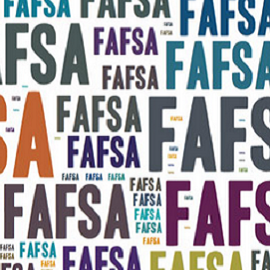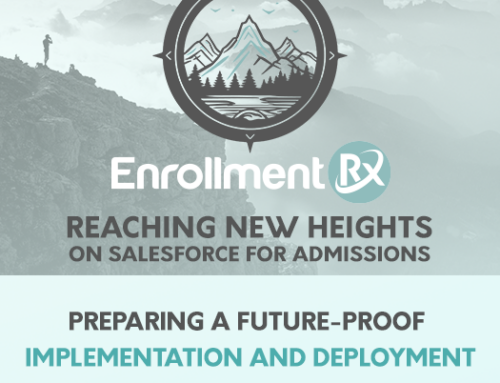As higher education institutions are now well aware, as of October 2016, families will be able to file the Free Application for Federal Student Aid (FAFSA) college aid form for financial aid eligibility using prior-prior year income.
As this Forbes article explains, “This new method is referred to as prior-prior, because students’ college financial aid eligibility will now be based off of income from two years prior to when a student enrolls in college, not one year prior the way the rule has been until today.”
Questions abound, though. At the recent Council for Christian Colleges & Universities (CCCU) Chief Enrollment Officers Conference, VPs of Enrollment Management and Directors of Admissions were abuzz with how to respond to the new rules. My SIS isn’t set up to handle this! How are we going to get financial aid offers out sooner? Do we need to set tuition earlier? Admit students earlier?
Amidst an increasingly competitive higher ed landscape – especially among those private and public schools who rely on the FAFSA form – these are urgent questions that need to be answered. A thoughtful approach to FAFSA can be yet another strategic initiative for schools to create competitive advantage.
Prior-Prior Year for competitive advantage
There’s no question that the change is welcome, and a long time coming.
For families, it means that they’ll know earlier in the process what their costs will be for higher education. Students will be more informed about their options for financial aid eligibility sooner, which will likely lead to earlier enrollment. For schools, this is an opportunity to recruit and communicate with more detailed financial aid information sooner, allowing them to get more proactive about student engagement.
What can you focus resources on today to get proactive about student engagement? Here are four practical and strategic tips to help Admissions teams leverage technology to prepare for prior-prior year and use the new rules to your advantage.
1– Move up your communications plan. According to a recent Noel Levitz blog — “Some campuses now preparing in earnest for new FAFSA rules for prior-prior year”, 61.7% of four-year private institutions and 71.4% of four-year public institutions polled plan to respond to the new FAFSA rules by “adjust[ing] content and timing of communication flows to prospective students.”
With prior-prior year in place, plan to move up your communications plan by at least six months. One way to facilitate this is to introduce more automation — by automating communications plans, you’ll be on top of identifying and engage with students earlier in the student lifecycle. Amidst changing rules and regulations, having a CRM tool to quickly automate communication flows and adjust your communications strategy can be the make-or-break difference for competitive advantage.
2 – Get those students on campus earlier. During a Noel Levitz presentation at CCCU, the presenters shared that a student who visits a campus has a 40% higher yield rate. With an accelerated timeline under the new rules, early campus visits will be more important than ever. As you look to get prospective students on campus earlier, evaluate the capabilities of your event management tools: Are you able to efficiently manage events, track invitations and student schedules? Do you have QR code check-in? Do your online event tools put your school’s best foot forward in creating that first impression for students?
When you focus on maximizing your ability to manage events and student information at every phase of the lifecycle, it will have a direct impact on your campus visit and yield rates. (If you’re looking to make event management a priority, check out our “CRM Event Management Made Simple” webinar)
3 – Work cooperatively with other departments. While Admissions and Financial Aid departments may feel deep-rooted friction over how to communicate with the student, prior-prior year should be the catalyst for collaboration. If Admissions can work closely with the financial aid department to get the “shopping sheet” into students’ hands more quickly, students will be better informed about cost of attendance and can budget and plan accordingly. This also requires early collection of documents. The earlier you get student information on file, the better chances you have to get that student through the application, financial aid and enrollment processes quickly and painlessly.
As one school recently shared with me, the Athletics department are already showing excitement over prior-prior year rules. If Athletics can give students projected financial aid budgets earlier in the recruiting process — even in students’ sophomore year – they’ll have a better chance of attracting their top recruits.
4 – Get your technology house in order. When the only constant is change, it’s important to ensure your technology systems are ready for anything. The new FAFSA rules are just one example of policy changes that can hit you at any time, and you want — no, you need — to be ready.
The underlying issue is that if schools are relying on a SIS to manage student recruitment and enrollment processes, they are at a major disadvantage. SIS are not set up to create communications plans, to manage events, to effectively recruit and nurture relationships throughout the student lifecycle.
Add to that deficit the dynamic industry pressures such as the prior-prior year update, and schools are set back further. Traditional ERP and SIS vendors are slow to adapt to industry changes. As a result, many schools we hear from are at a standstill, waiting for ERP or SIS updates that will allow them to handle prior-prior year. They’re stuck.
While the timeline would be too aggressive to meet this year’s FAFSA rules, as a long-term strategy, schools need to consider putting a CRM in place to transform their ability to dynamically shift their communications strategy, based on both internal and external needs.
If you have questions on prior-prior year and what it means for Admissions, contact us. We’re here to help.
Contact us here or call us at (847) 233-0088 to discuss your prior-prior year strategy, and hear how Enrollment Rx clients are getting ahead of it.




